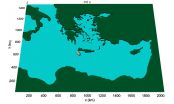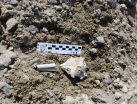(Press-News.org) Each spring, powerful dust storms in the deserts of Mongolia and northern China send thick clouds of particles into the atmosphere. Eastward winds sweep these particles as far as the Pacific, where dust ultimately settles in the open ocean. This desert dust contains, among other minerals, iron -- an essential nutrient for hundreds of species of phytoplankton that make up the ocean's food base.
Now scientists at MIT, Columbia University, and Florida State University have determined that once iron is deposited in the ocean, it has a very short residence time, spending only six months in surface waters before sinking into the deep ocean. This high turnover of iron signals that large seasonal changes in desert dust may have dramatic effects on surface phytoplankton that depend on iron.
"If there are changes to the sizes of deserts in Asia, or changes in the way people are using land, there could be a larger source of dust to the ocean," says Chris Hayes, a postdoc in MIT's Department of Earth, Atmospheric, and Planetary Sciences (EAPS). "It's difficult to predict how the whole ecosystem will change, but because the residence time [of iron] is very short, year-to-year changes in dust will definitely have an impact on phytoplankton."
The team's results are published in the journal Geochemica et Cosmochimica Acta. Co-authors include Ed Boyle, a professor of ocean geochemistry at MIT; David McGee, the Kerr-McGee Career Development Assistant Professor in EAPS; and former postdoc Jessica Fitzsimmons.
Dust to dust
Certain species of phytoplankton, such as cyanobacteria, require iron as a main nutrient to fuel nitrogen fixation and other growth-related processes. Hayes estimates that up to 40 percent of the ocean contains phytoplankton species whose growth is limited by the amount of iron available.
As desert dust is one of the only sources of oceanic iron, Hayes wanted to see to what extent changing levels of dust would have an effect on iron concentrations in seawater: Does iron stick around in surface waters for long periods, thereby making phytoplankton less sensitive to changes in incoming dust? Or does the mineral make a short appearance before sinking to inaccessible depths, making phytoplankton depend much more on seasonal dust?
To get answers, Hayes and his colleagues traveled to Hawaii to collect ocean samples at a station called ALOHA, the site of a long-term oceanography program conducted by the University of Hawaii. In September 2013, the team took a half-day cruise into open ocean, and then spent two weeks collecting samples of ocean water at varying depths.
The researchers acidified the samples and transported them back to the lab at MIT, where they analyzed the water for both iron and thorium -- a chemical element that is found in dust alongside iron. As it's difficult to determine the rate at which iron sinks from the ocean's surface to deep waters, Hayes reasoned that thorium might be a reasonable proxy.
Thorium has a number of isotopes: Thorium-232 is typically found in dust, and thorium-230 is produced from the decay of uranium, which decays to thorium at the same rate throughout the ocean. By comparing the amount of thorium-230 detected in ocean samples to the amount produced by uranium decay, Hayes was able to calculate thorium's removal rate, or the time it takes for the chemical to sink after settling on the ocean's surface.
This removal rate, he reasoned, is equivalent to the input rate of dust, or the rate at which dust is supplied to an ocean region. As the composition of an average desert dust particle is known, Hayes then extrapolated the input rate to estimate iron's residence time in surface waters.
A small piece of a big question
The team found that on average, iron tends to stay within 150 meters of the ocean's surface -- the layer in which phytoplankton resides ¬-- for about six months before accumulating on larger particles and sinking to the deep ocean. This residence time leaves a relatively short period for phytoplankton to absorb iron, making the organisms rather sensitive to any changes in incoming desert dust.
"Dust can change a lot from season to season -- by an order of magnitude," Hayes says. "From satellite images, you can see big pulses of dust coming from these deserts. That could change with climate change, and different precipitation patterns. So we're trying to keep track: If it does change, will it have an impact?"
As phytoplankton play a natural role in removing carbon dioxide from the atmosphere, better estimates of iron residence times, and desert dust inputs to the ocean, may help scientists gauge phytoplankton's role in combating climate change.
"It's a very small part that we're getting more quantitative about," Hayes says. "It's one piece that adds to trying to make the prediction: If there's more dust, will the ocean take up more carbon? That's a big-picture question that we can't totally answer with this, but we have one piece on the way to answering that."
INFORMATION:
This research was funded in part by the National Science Foundation.
Additional background
ARCHIVE:
Ocean acidification may cause dramatic changes to phytoplankton
ARCHIVE:
Bacteria: A day in the life
ARCHIVE:
Winners and losers in a warming ocean
Women lag behind men in the lucrative computer science and technology industries, and one of the possible contributors to this disparity is that they're less likely to enroll in introductory computer science courses.
A new study of 270 high school students shows that three times as many girls were interested in enrolling in a computer science class if the classroom was redesigned to be less "geeky" and more inviting.
The results, by University of Washington researchers, reveal a practical way for teachers to help narrow the gender gap in computer science by helping ...
About 10 percent of mothers experienced chronic, persistent depressive symptoms two years after Hurricane Katrina slammed into the Gulf Coast, killing more than 1,800 people, displacing hundreds of thousands and causing widespread damage estimated at more than $100 billion, according to a Georgia State University study.
While most people don't develop persistent depression after a major disaster like that, a small but significant number will, according to a study led by Dr. Betty S. Lai, assistant professor of epidemiology and biostatistics at the School of Public Health ...
A team of European researchers have developed a model to simulate the impact of tsunamis generated by earthquakes and applied it to the Eastern Mediterranean. The results show how tsunami waves could hit and inundate coastal areas in southern Italy and Greece. The study is published today (27 August) in Ocean Science, an open access journal of the European Geosciences Union (EGU).
Though not as frequent as in the Pacific and Indian oceans, tsunamis also occur in the Mediterranean, mainly due to earthquakes generated when the African plate slides underneath the Eurasian ...
For over a century, nitroglycerin has been used medically - particularly in the treatment of angina, or chest pain. It is a safe, cheap and effective treatment. Now, according to the latest study in ecancermedicalscience, researchers find that nitroglycerin is the latest in a series of medicines that could be repurposed to treat cancer.
The Repurposing Drugs in Oncology (ReDO) project, an international collaboration between the Anticancer Fund, Belgium, and US based GlobalCures, finds that existing and widely-used non-cancer drugs may represent a relatively untapped source ...
Physicists at the University of Basel succeed in synthesizing boron-doped graphene nanoribbons and characterizing their structural, electronic and chemical properties. The modified material could potentially be used as a sensor for the ecologically damaging nitrogen oxides, scientists report in the latest issue of Nature Communications.
Graphene is one of the most promising materials for improving electronic devices. The two-dimensional carbon sheet exhibits high electron mobility and accordingly has excellent conductivity. Other than usual semiconductors, the material ...
When they're not being the stars of various animated movies, penguins are playing an important role in evolutionary studies. Penguins are unique among modern birds in that they 'fly' through the water. Although flightless in air, penguins have a number of adaptations which allow them glide effortlessly through the water. And some of these adaptations are in an unlikely part of their anatomy - their brains. Recent finds of fossil penguins from 35 million year old sediments in Antarctica have begun to shed light on the changes in penguin brains that accompanied their ...
More than a cause of a simple infection, viruses are often involved in the development of serious diseases. Such is the case with liver cancer, which often develops in an organ that has been weakened by hepatitis B or C virus. Researchers at Inserm, the Paris Public Hospitals (AP-HP), Paris Descartes University, Paris 13 University (USPC), and Paris Diderot University have just identified the role of a new virus, hitherto unsuspected, in the occurrence of a rare type of liver cancer.
This study, based on follow-up and observation of 193 patients, is published in the 24 ...
Consumers aren't embracing electric cars and trucks, partly due to the dearth of charging stations required to keep them moving. Even the conservation-minded are hesitant to go electric in some states because, studies show, if fossil fuels generate the electricity, the car is no greener than one powered with an efficient gasoline.
Charging cars by solar cell would appear to be the answer. But most cells fail to meet the power requirements needed to directly charge lithium-ion batteries used in today's all-electric and plug-in hybrid electric vehicles.
Researchers at ...
New research published in Acta Obstetricia et Gynecologica Scandinavica, a journal of the Nordic Federation of Societies of Obstetrics and Gynecology, found that pregnant women in Sweden had inadequate levels of iodine in their diets. Proper iodine nutrition is necessary for neurological development of the fetus.
Iodine is an element that is involved in the production of thyroid hormones. Pregnant and breastfeeding women need about 50% more iodine in the diets, and WHO recommends a total daily iodine intake of 250 μg/d for pregnant and lactating women. Medical evidence ...
Probiotics show no benefit for preventing or eliminating gastrointestinal colonization with drug-resistant organisms in patients in the intensive care unit compared to standard care, according to new research published online today in Infection Control & Hospital Epidemiology, the journal of the Society for Healthcare Epidemiology of America.
"Our research suggests that probiotics do not help prevent gastrointestinal colonization with multidrug-resistant organisms in critically ill patients," said Jennie H. Kwon, DO, lead author of the study.
This prospective, randomized ...

